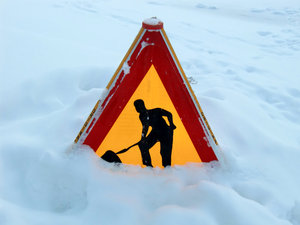Winter weather creates a variety of hazards that can significantly impact everyday tasks and work activities. According to the Occupational Safety and Health Administration (OSHA), common winter work dangers include environmental cold, strong winds and slippery surfaces.

As the wind picks up, so do the risks for a injury/illness, especially to those who work outside for prolonged periods of time. Construction workers, snow cleanup crews, police officers, recreational workers and firefighters are at greater risk. Also at risk, and less commonly thought of are landscapers, water transportation, baggage handlers, transit and other outdoor operations.
Cold stress may be present in many different forms, affecting the whole-body heat balance as well as the local heat balance of extremities, skin and even lungs. The natural means of dealing with cold stress is by behavioral action–in particular, change and adjustment of clothing. Sufficient protection prevents cooling. Our workers’ compensation lawyers know prolonged exposure to cold, often associated with insufficient clothing or physical activity, may result in whole-body cooling and a decrease in core temperature. This type of cooling is further aggravated by exposure to wind or cold water, which increases especially the convective heat loss to the environment.
In order to survive and stay active in the cold, the constant heat loss has to be counterbalanced by the production of an equal amount of heat. Heat is both required and produced at the cellular level as a result of complex metabolic processes that convert food – a primary source of energy – into glycogen. Glycogen is a substance (biochemical compound) that is the “fuel” for biochemical processes underlying all life functions, heat production included.
Tips for Staying Warm on the Job:
-Keep an eye on the wind chill. Don’t just keep an eye on the temperature. When it’s windy, make sure you wear warmer clothing. Wind chill decreases outdoor temperatures.
-Add on the layers. Lawyers help to keep the warm air in and around your body. Try wearing a scarf, a hay, synthetic wool, mittens, hand warmers, sweatshirts and zipable over lawyers.
-Double layer thermal socks and insulated boots – good idea if you’re going to be standing or walking on cold surfaces. Steel toes are notorious for acting as a “cold sink.” When possible ask for a composite toe, which is almost as strong. Also, try to stand on a mat, plywood or other insulating barrier if you’ll be out in the cold for long periods.
-Know the symptoms of hypothermia. These oftentimes include constant shivering, fast breathing, confusion, drowsiness, difficulty moving, unconsciousness, weak or irregular pulse and dilated pupils.
If a person cannot generate enough heat from muscle activity to replace that being lost, or if they are not wearing suitable clothing to protect from heat loss, then hypothermia can occur.
Employers should train workers how to recognize the environmental and workplace conditions that can lead to cold stress.
Call Jeffrey Glassman Injury Lawyers for a free and confidential consultation to discuss your workers’ compensation claim– (617) 777-7777.
More Blog Entries:
New Bedford Man Killed in Shellfish-Shucking Machine, Massachusetts Workers’ Compensation Lawyers Blog, February 4, 2014
Endangered Hospital Workers an OSHA Focus in 2014, Massachusetts Workers’ Compensation Lawyers Blog, January 29, 2014
 Massachusetts Workers Compensation Lawyers Blog
Massachusetts Workers Compensation Lawyers Blog

